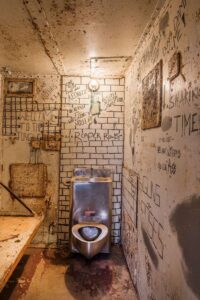

Everyone has heard of jail and prison, but what happens in between? Receiving, in the Department of Corrections (DOC) is a special facility where people are taken to be assigned to the “correct” prison, according to their charges, their history, and various personal characteristics that are used to assess their needs and their security risk. This assessment is a cold and calculated numbers game designed to place individuals into the box where they will exist for the years and months of imprisonment that follow. In the state of Oklahoma, men are processed in Lexington Assessment and Reception Center (LARC), and the journey begins in county jail.
One man, convicted in Leflore County, recounts his experience with the transfer. A lifelong law-abiding citizen, he had never been exposed to the harsh truth of how human beings are treated behind bars until he was suddenly arrested on false charges. He first heard of receiving from others in jail, before posting bond. Some prison-bound men spent months in the Leflore County Detention Center (LCDC) waiting to go to Lexington Assessment and Reception Center (LARC). He knew that men were transported in groups, without any kind of warning. Years later, the lengthy legal battle for his innocence was punctuated by a coerced plea deal. He was immediately detained in the courtroom, and held in Leflore County for two weeks before being transported to Lexington.

“At around four in the morning, guards got everyone ready to go to Lexington.” he recalls, with the events still fresh in his mind, “In all, there were 14 of us. They drove us in the middle of the night until we reached Receiving at around eight. The sun had just come up.” The entered through a military style checkpoint complete with fully enclosed chain link, barbed wire, and razor wire fences. From there, they went to the concrete block Receiving building. The buses pulled in and they were let out. They went into an area that looked like a garage, and had the handcuffs removed while the guards gave the men their instructions.
Once done, they went inside, and were made to sit on the benches while waiting to be processed. “It was organized chaos,” he says of the process that followed. First, everyone got a haircut; very short with no facial hair. Next, they had to change out of their County clothes into the Department of Corrections uniforms. They were dull grey, and very ill-fitted. This included underwear and socks. “This was done in front of around ten other guys,” he explains, “If you have underwear that meets DOC uniform specs, then you may keep that. They keep the shoes but you’ll get those later.” That means the undergarments must be plain white in color, and sufficient for Department of Corrections standards. “Next, you go back to the bench.” he continues, “Most of the day is spent waiting on the bench.”

After uniforms the men are taken to medical, where they are put through a barrage of tests. “They stick you and suck out a lot of blood, then inject you with a tuberculosis test,” he recalls, “Then an eye exam, and about a million questions about your health.” Once the medical examination is finished, they take fingerprints and mugshots. When it’s done, it’s time for the initial consult. “They ask what you did, and how you feel about it, and a dozen other questions.” he says, “They’ll give you some information but you can’t rely on it.” Those who are falsely accused, like the man in the interview, find themselves in a difficult spot during this stage of the assessment. Generally, the State wants to see inmates “Take responsibility” for their charges. Doing so earns him or her brownie points that can translate to a more favorable assessment and a lower security level. If the person truly committed no crime, he or she is faced with the dilemma of whether they should remain committed to the lie they pled to, or tell the truth and risk the consequences of being seen as a liar by the assessor.
Finally, after spending most of the day on the bench, the men are taken back to get property; which includes shower shoes, quasi regular shoes, and a tablet. “Everything is efficient, but seemingly chaotic,” the man comments. While the people are doing their jobs, other inmate trustees are involved in a variety of other activities, such as delivering Bologna sandwiches, and sweeping up hair. There is also a group that goes around offering Bibles and praying for people.
After some more time on the bench, individuals are led back to a “quad,” which is a group of cells arranged around a central concrete courtyard. There are four alike with a guard booth and offices in the middle. “This is your new home for a few weeks.” he explains, ”The cells are nasty, small, and hot. They consist of a prison sink/toilet, bunk beds, and a desk. There is a window with no view; all it’s good for is trapping heat.” At least two people will inhabit a cell like this, but they are not alone. “Bedbugs, cockroaches, and other things live there, too.” he illustrates with disgust.

Lexington houses people of various security levels, so the facility is treated like a maximum security prison. Cells are locked down all day and night, except for one hour a day each weekday. This is a chance to shower, as there are no showers in the cells. Lexington Reception and Assessment Center doesn’t allow typical commissary; only a limited number of hygiene items. Each person is given a flat mat to sleep on, a towel, their clothes, a small care kit, a cup, toilet paper, and a blanket. Physical books and letters aren’t allowed. Mail is scanned and uploaded to people’s tablets powered by Securus; a third-party network specializing in inmate communications. There are no in-person visits. All phone, messaging, and media access is processed by Securus, but is subject to review by the staff at Lexington.
During the week, people are called out of their cells for different things. First, they’ll be called for a psychological assessment. They ask a number of mental health questions, from “Are you depressed?” to “Do you believe that you have super powers?” A few days later, individuals are pulled out for dental and medical checkups. If you require prescription medication, that’s the point at which you can get it. “Other than that, you’re sitting and waiting to find out where you’re going, and waiting for that place to have room.” the man concludes, “In all, it is nasty with occasional bouts of chaos. You’re housed with people of similar charges so mostly the challenge is in dealing with the boredom, and nasty surroundings.”

At the time of this writing, the person we spoke with is still in the process of being assessed. He has not been told where he is going, or when. The uncertainty is by design. It’s policy not to inform inmates or their loved ones about where or when they will be moved until after the move has happened. The person inside can only hope loved ones can accept a collect call, or access online resources such as VINE (The Victim’s Information Network), or the Oklahoma DOC website. The inelegant transition from jail to prison is marked by grueling assessments, nasty conditions, unending boredom, and minimal contact with the outside world while people wait for the next prison bus to come in the middle of the night.

















